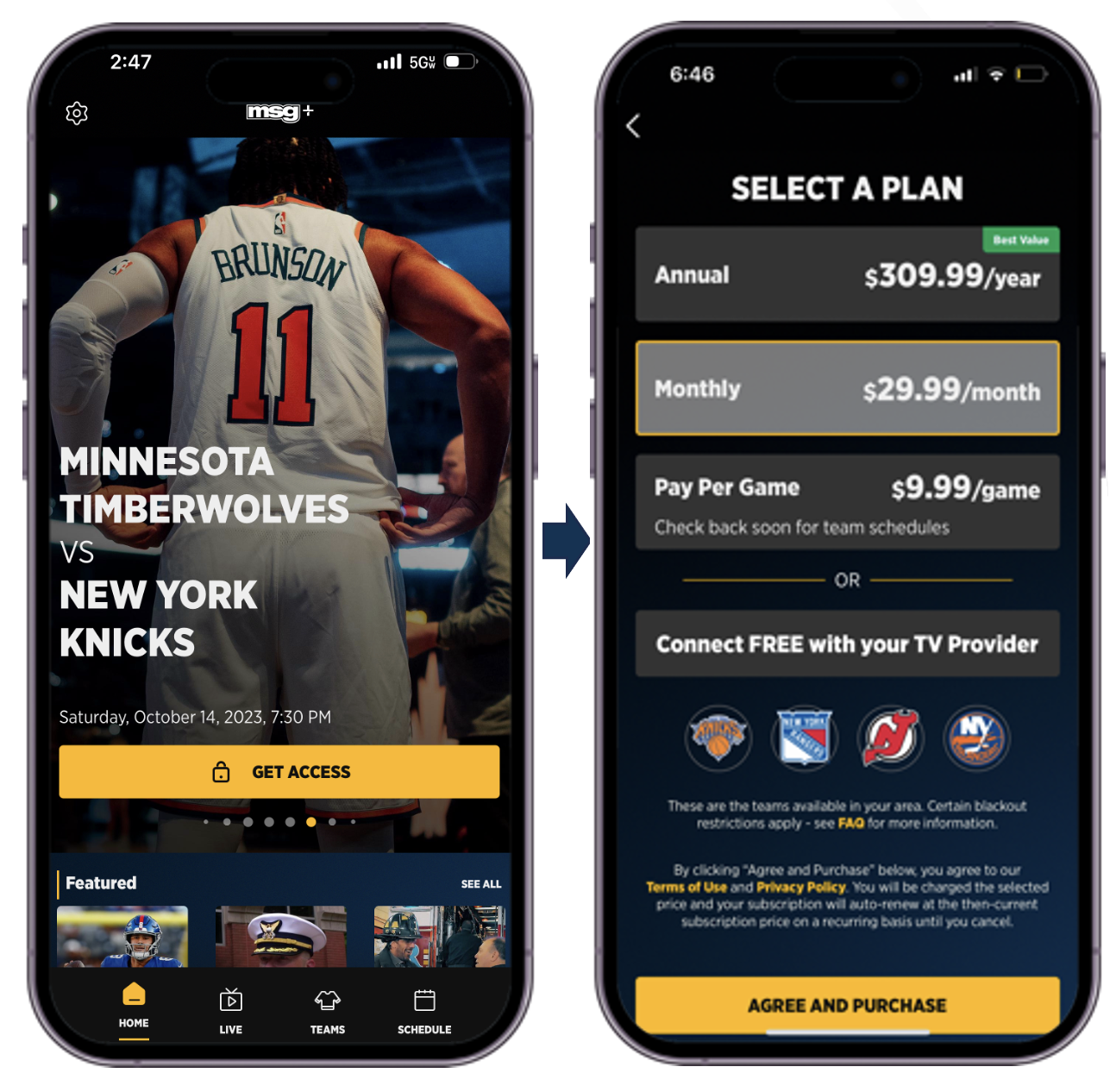MSG+ Launches In-Market Streaming; New Tech Stack Powers New Flexibility
The app is intended for both DTC consumers and cable subscribers
Story Highlights
It’s a fresh new season for NBA and NHL fans, and, for those in the New York City area, there is a fresh new way to catch their favorite Tri-State–area teams: MSG+, a new app from MSG Networks, features a new tech stack, the ability to subscribe per game vs. per month or year, and much more. It is also a single app experience designed for both DTC consumers and cable subscribers, who can access content via authentication.
“We decided to combine [the DTC and cable] audiences into one app and focus on one premium experience,” says David Schafer, SVP, product, technology and operations, MSG Networks. “We were determined to develop one premium experience for our fans, regardless if they were a cable subscriber or a fan that wants to engage with us directly. This approach has enabled our teams to focus on our single mission without juggling various products and also mitigates risk with one product and one technical stack.”
Subscribers will be able to access New York Knicks, New York Rangers, New York Islanders, and New Jersey Devil games broadcast on MSG across the Tri-State area (New York, New Jersey, and Connecticut). The Buffalo Sabres are also available on MSG+ in Western New York. Authenticated cable subscribers can access the action for free, and fans without cable can buy individual games for $9.99, a monthly subscription for $29.99, or a full-year subscription for $309.99. The app also features full season schedules and allows users to set reminders to subscribe to a game or tune in.
Having one app (MSG+ is currently available for iOS v15 and above for iPhone/iPad, Android v9 and above for Android phones or tablets, via the web, or on Samsung, AndroidTV, and Apple TV) and one technical stack offers efficiencies that ultimately make the experience better for the internal team and the fan. According to Schafer, the previous MSG GO tech stack dated to 2013, and, although it was stable, an entirely new stack opens up many new possibilities for services and more.
“To build out a new tech stack,” says Schafer, “we engaged with premium partners — such as Intive, Quickplay, Harmonic, Evergent, mParticle, and Mixpanel — and continue to leverage our existing partnership with Freewheel.”
He believes that, while engaging with many third-party vendors instead of relying on internal teams can present challenges, nurturing a culture as one team is crucial, with full transparency and open communication lines.
“There are different approaches to outsourcing, including a full turnkey approach,” Schafer notes, “but MSG went down that path of driving the detailed roadmap with clear prioritization and managing resources across our partners. I believe this approach has led to our early success and is evident in the product and one cohesive team.”
At the center of the experience are the live games. The home screen emphasizes upcoming games, with the promo rail graphics dominating the screen and the navigation.
“That app will be curated every day, pointing to our live events, channels, and extensive library,” says Schafer. “As we approach game time, the experience will transition to that day’s live game coverage and the content that surrounds that event, such as studio shows, player profiles, live stats and odds, and highlights. But, if a fan prefers a more laid-back approach, a user is never more than one or two clicks to our live channels MSG, MSGSN, MSG2, or MSG2SN.”
The tech stack also can support future enhancements — HDR, 4K, interactive elements — but the focus for now is a live-game experience.
“We had a short runway to build MSG and wanted to successfully deliver a high-quality, stable experience,” he says. “So we focused on what was most important, and that is the live game and our channels. We have a long list of future roadmap items, such as more personalization and audience-retention experiences, but we will make decisions as we start to see engagement data.”
Fans will also be able to find highlights and condensed games.
“We are thrilled to have partnered with WSC Sports to deliver automated highlights, with quick turnarounds on packages like condensed quarters and games,” says Schafer. “Our users can restart a game or have the ability to instantly view quarter or period recaps, along with full-game recaps after the game.”
A soft launch this summer gave the internal team and vendor partners a chance to make any tweaks before the start of the NHL season, which began last week, and the NBA season, which tips off on Oct. 24.
“Given that we deliver five teams across five geographical zones,” Schafer adds, “the tech stack is flexible, agile, and scalable. We modeled the same approach that Discovery had with the DTC services delivering across multiple international territories. Having zones is an interesting aspect to the architecture we’ve built: it’s not just about new product features but also the ability to scale up and down as we see fit.”
Helping in those efforts is a dedicated streaming-product and tech team and a content-publishing team that leverages content created for the linear network and sports teams.
Says Schafer, “The company has been extremely supportive in developing and delivering this new experience.”

